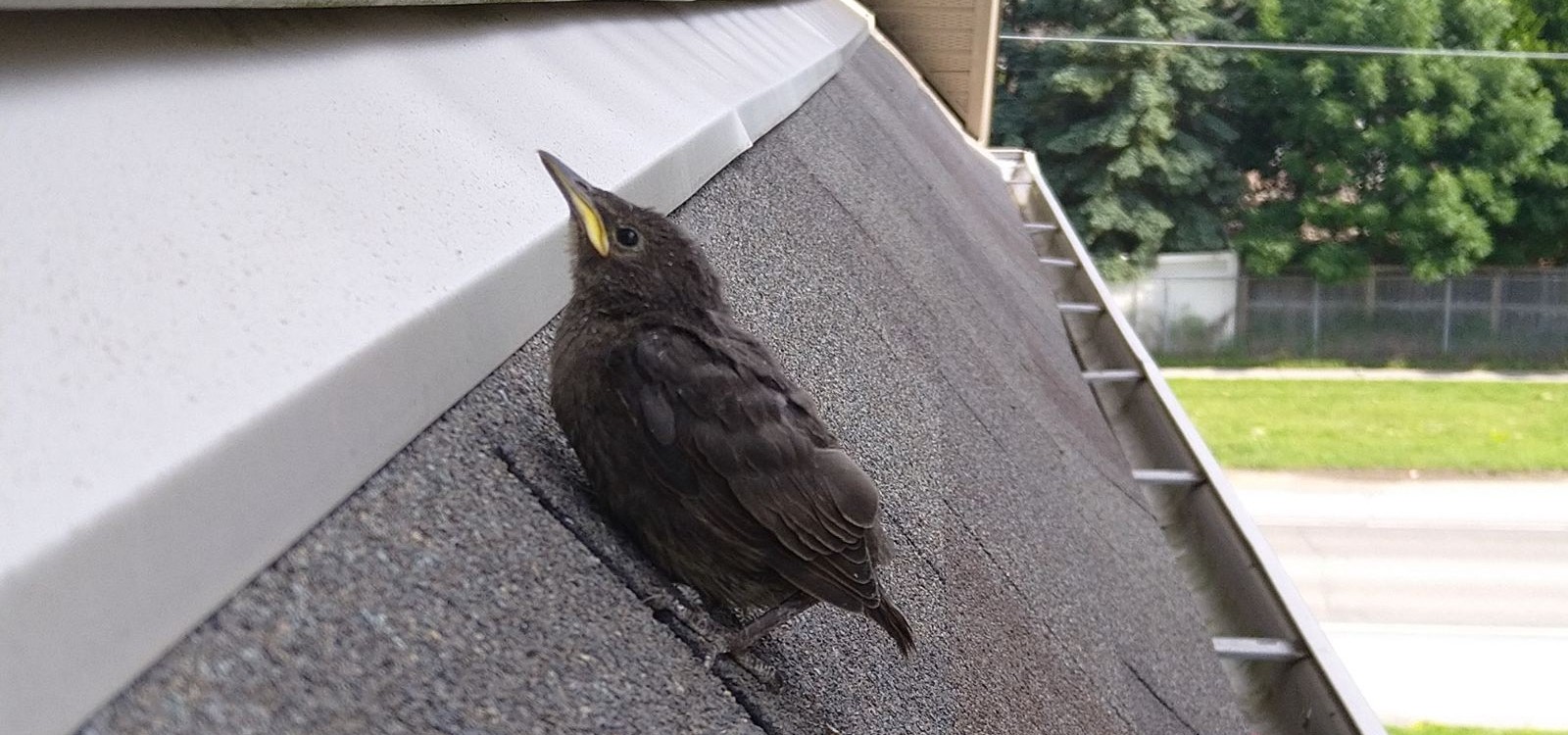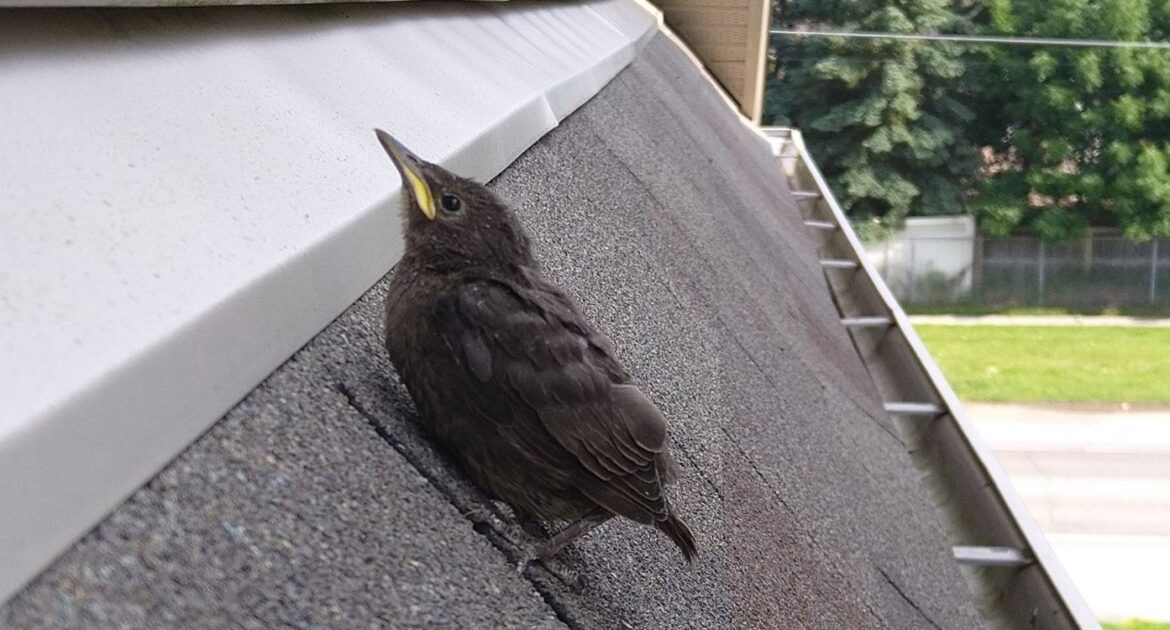Finding a bird’s nest in your dryer vent can be both surprising and concerning for Columbus homeowners. It is a prevalent issue, especially during nesting season when birds seek warm, sheltered spaces to raise their young. At Skedaddle Humane Wildlife Control, we’ve helped countless homeowners safely address this situation while protecting both their homes and the birds involved.
Your dryer vent’s warmth and shelter can attract unexpected feathered guests looking for the perfect nesting spot. But our experts are here to offer guidance and help in protecting your home and family’s safety while also protecting wildlife.
Why Birds Choose Your Dryer Vent
Understanding why birds target dryer vents is the first step in preventing this issue. Birds are naturally drawn to these home features for several compelling reasons:
- Warmth and shelter: Dryer vents provide consistent warmth, especially during cooler months when your dryer is running, creating an attractive microclimate for nesting.
- Protection from predators: The enclosed design of vents offers safety from predators like hawks, raccoons, and neighborhood cats.
- Convenient location: Most dryer vents are positioned at heights that are accessible yet challenging for ground-based predators.
- Stable structure: Unlike tree branches that move in the wind, vents provide a stable platform for building nests and raising young.
Species most likely to nest include European starlings, house sparrows, and various native songbirds, which are particularly adapted to urban environments and have learned that human structures often provide excellent nesting opportunities. Recognizing these dynamics can help you better notice the early warning signs of bird nesting in your vent system before a full nest is established.
Signs a Bird Has Nested in Your Dryer Vent
Detecting bird nesting in dryer vent systems early can save you significant trouble down the road. Here are indicators that birds have made themselves at home in your vent:
Visual and Auditory Clues
- Reduced airflow: Your dryer takes longer than usual to dry clothes, or you notice less air coming from the exterior vent opening.
- Unusual sounds: Chirping, scratching, or rustling sounds coming from the vent or wall where the vent runs, especially in early morning or evening hours.
- Visible nesting materials: Twigs, grass, feathers, or debris protruding from the vent opening or scattered on the ground beneath the vent.
- Bird activity: Frequent visits by birds to your vent area, particularly if they appear to be carrying nesting materials in their beaks.
Physical Evidence
- Droppings on walls or the ground beneath the vent opening, often white or gray in color.
- Feathers caught in the vent cover or scattered nearby.
- Partial blockage of the vent flap, preventing it from closing properly when the dryer isn’t running.
Warning signs within your home might include a burning smell when using your dryer, which could indicate that nesting materials are blocking the vent and causing overheating—a serious fire hazard requiring immediate attention. Recognizing these signs early allows you to address the situation before it results in more significant problems for both your home and the birds involved.
The Dangers of Birds Nesting in Your Dryer Vent
When birds establish nests in your dryer vent, they create several dangers that can impact both your home’s safety and your family’s health. Understanding these risks underlines the importance of prompt bird in dryer vent removal.
Fire Hazards
The combination of flammable nesting materials and hot dryer exhaust constitutes a profound fire risk:
- Lint buildup: Nesting materials trap dryer lint, which is extremely flammable and can ignite when exposed to high temperatures.
- Airflow restriction: Blocked vents cause dryers to work harder and run hotter, increasing the risk of mechanical failures or electrical fires.
- Extended dry times: When your dryer runs longer to compensate for reduced airflow, components can overheat and potentially fail.
Health Concerns
Bird nesting in dryer vents introduces several health hazards:
- Airborne particles: Bird droppings can dry and become airborne, potentially containing harmful bacteria and fungi.
- Parasites: Birds carry mites, ticks, and other parasites that can find their way into your home.
- Respiratory irritants: Feathers, droppings, and nesting materials might contain allergens that trigger respiratory issues, especially in sensitive individuals.
Property Damage
Beyond safety concerns, bird nests can cause costly damage:
- Structural deterioration: Bird droppings are acidic and can damage the exterior of your home over time.
- Vent system damage: Birds may damage vent covers, ductwork, or the dryer itself during their nesting activities.
- Increased energy costs: When your dryer works harder due to restricted airflow, your utility bills can noticeably spike.
These dangers highlight why addressing a bird nest in your dryer vent should be a priority for Delaware homeowners.
Legal Considerations for Bird Nest Removal
Before attempting any bird dryer vent removal, it’s crucial to understand the legal framework that protects various bird species. These laws can significantly influence how and when you can address birds nesting in your home.
Protected Species in Ohio
Under the Migratory Bird Treaty Act and Ohio state laws:
- Native songbirds: Most native bird species are protected, making it illegal to disturb active nests or harm birds without proper permits.
- Exceptions: European starlings, house sparrows, and pigeons are non-native species not protected by federal law, allowing homeowners more flexibility in managing these specific birds.
- Seasonal restrictions: Even for non-protected species, local ordinances or seasonal considerations might restrict removal activities during breeding seasons.
Professional Assistance
At Skedaddle, we understand these legal nuances and can assist you in navigating them:
- Proper identification: We can identify the bird species involved, determining whether they’re protected.
- Legal compliance: Our technicians are trained to comply with all relevant wildlife protection laws.
- Permit acquisition: When necessary, we can work with appropriate agencies to obtain permits for removing protected species in emergency situations.
Understanding these legal considerations helps ensure your bird removal efforts don’t result in unwanted legal issues or harm to protected wildlife.
How Our Experts Deal with Unwanted Birds Nesting in a Dryer Vent
At Skedaddle Humane Wildlife Control, we understand how stressful it can be to discover birds nesting in your dryer vent. That’s why our team of experts follows a safe, humane, and effective process to resolve the issue while protecting both your home and the birds. Here’s how we do it:
- Thorough Inspection
Our first step is to carefully inspect the dryer vent and surrounding areas to confirm the presence of a bird’s nest. We look for telltale signs like nesting materials, droppings, or reduced airflow. This helps us assess the situation and determine the best course of action. - Humane Removal
Once we’ve identified the nest, our trained professionals use specialized tools and techniques to safely and gently remove it. We always comply with local wildlife laws, ensuring that any protected bird species are handled with care and respect. - Cleaning and Sanitization
After the nest is removed, we thoroughly clean and sanitize the vent to eliminate any debris, droppings, or bacteria that could pose health risks. This step is crucial for restoring proper airflow and maintaining a safe environment in your home. - Preventative Measures
To stop birds from returning, we install durable, bird-proof vent covers that allow your dryer to function properly while keeping wildlife out. We also provide tips on maintaining your vents to prevent future nesting. - Ongoing Support
At Skedaddle, we’re committed to your peace of mind. If you have any questions or concerns after the removal, our team is always here to help.
Preventing Birds in Your Vents with Skedaddle
If you suspect birds are nesting in your dryer vent, don’t wait for the situation to escalate. Contact Skedaddle for professional, legal, and safe removal solutions.
By choosing Skedaddle, you’re not just solving a problem—you’re partnering with experts who prioritize humane solutions and long-term prevention. Let us help you protect your home and keep wildlife where it belongs!




